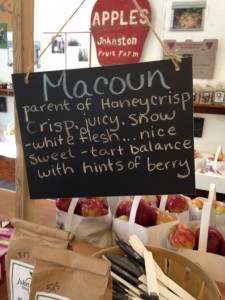Apples are good for nutritional health; mindfulness is good for mind-body well-being.
Along with other Ohio fruits like pears, plums, peaches and apricots, apples contain vitamin C, fiber and vitamin A, and the antioxidant quercetin. Quercetin works as an antioxidant as well as an anti-inflammatory, and has been associated with overall lung health. Although red apples contain the most quercetin, other fruits and apple varieties(PDF) also contain it. Those who practice mindfulness on a regular basis respond to stress in a more effective manner, are more focused at work and set the intention to live with purpose and clarity.
There are countless varieties of apples; there are numerous approaches to practice mindfulness. No one variety or approach is better than another.
Two common apples are Red Delicious and Granny Smith, but there are hundreds of apples grown commercially in the United States. A handful of varieties that grow in Ohio include: Macoun (a parent of Honeycrisp), Snow Sweet, Cameo, Winesap and Melrose.
While not an exhaustive list, here are some ways to practice mindfulness to support mind-body health
- Progressive muscle relaxation – a focused tension, hold and then relaxation of each muscle group in the body.
- Mindful body scan – focused attention on each body part to notice how it feels, without judgment or trying to change how it feel s
- Breathing – focus on the breath by fully inhaling and then fully exhaling the breath.
- Mindful movement – two examples include tai chi and yoga. Both of those examples have many different styles but the common features include graceful poses or postures, deep breathing and relaxation.
- Guided imagery or Visualization – could be a “story” or audio or written image
- Meditation – using silent time to calm the mind, sometimes silently repeating a word, thought or phrase to keep focused
 Individual recipes call for specific varieties of apples; separate life situations can utilize different mindful practices.
Individual recipes call for specific varieties of apples; separate life situations can utilize different mindful practices.
Many types of apples can be interchanged depending on availability but often, different varieties of apples(PDF) are recommended for certain dishes. For example, Cortland, Lodi and MacIntosh make a nice apple sauce and Gala and Jonagold work well in salads. Individuals are encouraged to find what mindfulness practices work best for them. Here are a few examples of mindfulness practices being used for specific life situations:
- Using guided imagery to prepare for a potentially stressful life event like the Wexner Center’s free guided imagery recording to prepare for surgery.
- Jon Kabat-Zinn first explored the effect of mindfulness meditation on chronic pain patients at the University of Massachusetts Medical Center decades ago. Studies have shown that patients report a 30 -50% decrease in physical and psychological symptoms by the end of the 8-week program.
- Parenting can be challenging and stressful and joyful and mindful. Parents and caregivers who practice mindfulness(PDF) increase the likelihood that they and their children will have a happier family life.
- Mindfulness practice is gaining respect as a holistic worksite wellness program to help employees be more engaged and reduce work-related errors and injuries.
- Those who practice mindfulness praise the ability to draw on general mind-body health in the midst of stressful situations. During those times, those who practice mindfulness are able to draw on the exercises such as deep breathing to get through the stressful moments without increasing stress.
Spices like cinnamon complement apple recipes well; tools like music complement mindfulness practices well.
While there are no required tools for any form of mindfulness, sometimes there are enhancements for the formal practice.
- Music playing during mindfulness exercise can help remind the mind and body that this is a time for relaxation.
- Physical props to teach a concept such as blowing on a feather to visualize exhaling all the breath out of the lungs.
- Depending on the type of movement, it is sometimes recommended to have a towel or mat for sitting or lying on the floor and comfortable clothing for stretching.
- Sometimes mindful practices happen during a silent period of time like 10 minutes or 20 minutes. In order to focus on the practice and not worry about the time lapse, it’s helpful to have a signal for starting and finishing. In a group setting, the leader might use a bell to start and end the silent period. In individual practice, a peaceful timer might be useful to indicate the end time.
- Additional lifestyle habits to complement mindfulness practice include other physical exercise, healthy eating, getting enough sleep and surrounding yourself with supportive friends and family.
To reap the nutritional benefits of apples, you have to eat them; to reap the mind-body benefits of mindfulness you have to practice them.
